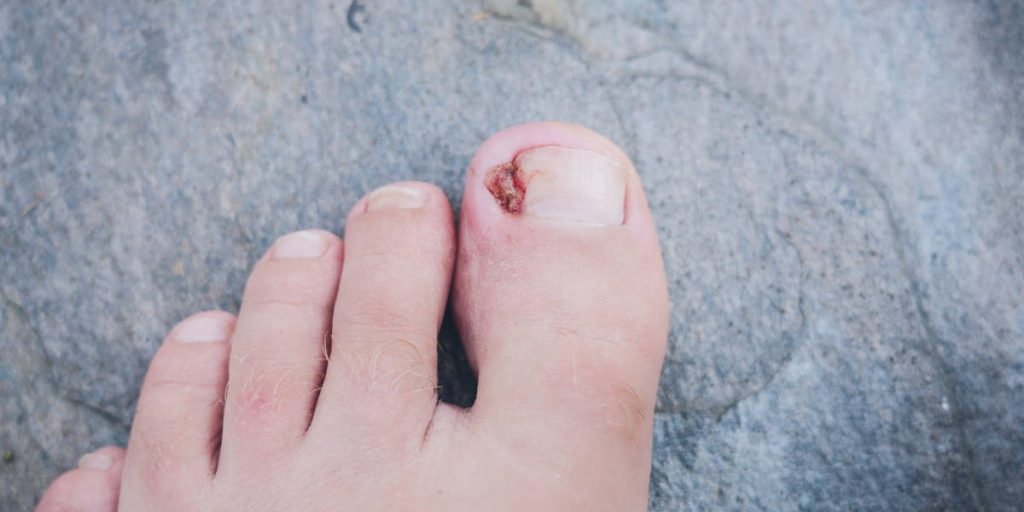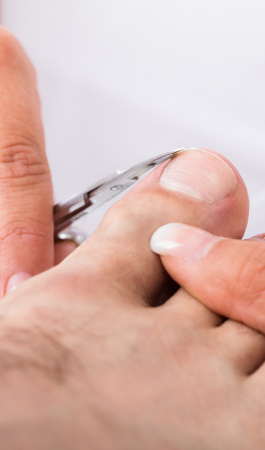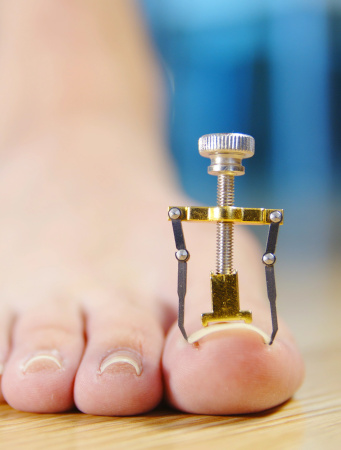Uncomfortably common and remarkably painful, ingrown toenails can often be treated with at-home care. However, every once in a while, this foot problem can grow serious enough to warrant a visit to the podiatrist – that is, the MD specializing in foot and ankle disorders, as well as other toenail conditions.
But wait, aren’t they supposed to be a simple problem with the edge of the nail – barely more complex than a callus?
While often seen as a minor inconvenience, if not treated properly, an ingrown toenail can become a gateway to more serious infections, including those caused by Staphylococcus aureus (also known as staph infections. These common skin bacteria have now acquired remarkable resistance to antibiotics.
When this happens, it’s time to bring in the big guns before your toes suffer any permanent damage!

What are ingrown toenails?
Ingrown toenails are when a corner of the nail begins to grow downwards and into the nail bed. As it grows, the nail can puncture the skin around the sides of the nail. This is generally uncomfortable, as you will feel a slight pinch every time you take a step or press that toe onto the floor. Ingrown toenails generally affect the big toe, which tends to support more weight.
How do ingrown toenails get infected?
Anything that pierces your skin opens the door to infection. Our skin is a natural barrier against pathogens, and once this barrier is compromised, bacteria can easily invade the underlying tissues. When it comes to the feet, however, the risk is compounded by a few factors:
- Feet spend a lot of time in a damp, dark environment.
- Feet, socks, and shoes often get into dirty floors and contaminated mud.
- Sweat also adds to this bacteria-happy environment.
- As feet are “out of the way,” they are often not washed or patted dry as often as our hands.
- Home pedicure tools, if not properly cleaned, can also carry bacteria.
Ultimately, there are bacteria and fungal spores on almost every surface. Staph is one of the most common, and it often lives on our skin already – turning it into one of the most common culprits of nail bed infections. Unfortunately, just because it’s common doesn’t mean it’s harmless: antibiotic-resistant strains such as MRSA (Methicillin-resistant staphylococcus aureus), which used to be confined to hospitals, now appear everywhere and are notoriously hard to treat.
Risk factors for infected ingrown toenails
Infected toenails are common enough, but some people are at a higher risk of developing them – either because they suffer from frequent ingrown nails or are more prone to infections in general. This includes wearing tight shoes, poor foot care habits, and having a naturally curved nail.

Any of these factors will increase your chances of developing an ingrown toenail. Once this happens frequently enough, you may eventually find an infection on your big toe.
However, there is one extra risk factor that dramatically increases your chances of having a severe, foot-threatening infection: having poor circulation or nerve damage in your lower limbs, feet, toes, and ankles. A common cause for this is poorly-controlled diabetes, and people with this condition may lose sensation in their feet – a condition called diabetic neuropathy. In turn, this means:
- You will be more likely to have a severe ingrown toenail and not notice it.
- The poor blood flow will make it harder for your body to fight the infection.
As a result, we prefer to take a more proactive approach to foot health for patients with these health conditions. Avoid tight shoes, keep your nails trimmed, take extra precautions to prevent injury, and routinely inspect your own feet for any new sores.
What are the symptoms of an ingrown toenail?
A mild ingrown toenail can usually be recognized by slight pain around the sides of the nail, which may be accompanied by mild redness. This simple home ailment can be fixed during an at-home or medical pedicure, provided all items used are sterile and the person knows what they’re doing.
Once you get an infection, however, you’ll need a medical foot specialist: after all, you may need an oral or topical antibiotic, which only a doctor can prescribe.
But how do you know it’s time for a doctor’s visit? Look out for any of these signs:
- redness around the entire toe
- lancing or throbbing pain when touched
- the toe and surrounding skin feel warm to the touch
- a foul smell coming from the corner of the nail
- pus oozing from beneath the nail bed
- an abscess directly beneath the nail or close to its edges
Any of these will signal a localized infection. However, only a doctor can determine what type of infection.
If the nails appear thick or ridged, it could be a sign of a fungal infection instead.
However, MRSA is currently one of the most common in the country, and it can often be recognized by its golden yellow discharge.
Signs of staph infection include red streaks spreading from the affected area and fever or chills. If not treated promptly, the infection can deepen, causing more severe problems such as abscesses or potentially spreading to the bloodstream and other body parts—a condition known as bacteremia.

To fight the infection, we may need to swab the infected area and send it to the lab for extra tests. This is known as a culture, and it can tell us exactly which medication your bacteria will respond best to – an antibiotic ointment, pills, or even local injections.
As antibiotic-resistant strains are now more common than ever, we sometimes need to get extra aggressive and use a combination treatment (for example, a course of tablets accompanied by an antibiotic cream).
To fix the nail itself, we also have several procedures available.
Lifting the nail
The simplest method is to lift the edge of the ingrowing nail with a pair of very fine tweezers, and this will stop it from pinching your skin. Then, we will slide cotton, dental floss, or gauze under it so it remains separate from the skin until it heals.
This process may take a few weeks, and the gauze or cotton will need to be replaced frequently.
Gutter splints
We can also use a “gutter splint” for deeper or curled ingrown nails. This is a tiny sterile tube with a slit to one side, which looks a bit like a rain gutter. By sliding it under the embedded nail, we can keep it raised and away from your skin.
This method requires us to use local anesthesia or a numbing agent. However, you won’t need to constantly replace the tube: it stays there until the nail grows above the edge of the skin.
Nail avulsion
This final option is a lot more complicated, so we reserve it only for the worst ingrown toenail cases or for people who have repeated problems on the same toe. A nail avulsion is the surgical removal of all or part of the nail and the skin under it to keep the nail from growing back.
After any of these methods, your toes are bound to be left a bit sore. You can take an OTC pain reliever or anti-inflammatory, such as Advil (ibuprofen) or Tylenol (acetaminophen). After a nail avulsion, you may need to stay off your feet for up to 24 hours.
Preventing ingrown toenail complications
Fortunately, you can prevent things from escalating this far by knowing how to help an ingrown toenail at home.
The first and most effective method is to wear comfortable shoes. This will prevent ingrown toenails in the first place, but even if you have a mild one, properly-fitted shoes won’t push it any further inside the skin.
You can sometimes trim a big ingrown toenail by yourself, as long as it has not gone too deep. Keep in mind you should never attempt to do this if you have low immunity, diabetes, or any condition that could cause nerve damage.
To do this, start by soaking your feet in warm water with Epsom salts to soften the nail and skin around it. Disinfect your nail files and nail clip thoroughly before and after use. It’s also best to apply an over-the-counter antifungal or antibacterial cream after you finish. If you see any blood at any point, cover it with sterile gauze and let a professional handle it.
Why choose the Foot and Ankle Institute for your ingrown toenail treatment?
Whether you are a slightly careless athlete or are actively trying to prevent diabetic foot problems, our nationally recognized foot and ankle specialists can help you get rid of both pain and bacteria. We specialize in all foot and ankle conditions, whether major rehabilitation, surgery, or prevention programs.
For more information or to schedule a consultation, please call (877) 736-6001 or make an appointment now.
We are conveniently located through the Los Angeles area with locations in or near Santa Monica, Beverly Hills, Sherman Oaks, West Los Angeles, Manhattan Beach, Northridge, Santa Barbara, Downtown Los Angeles, Westlake Village, Granada Hills, and Valencia.
- Do blood pressure medicines cause foot pain? - July 22, 2024
- What is erythromelalgia? - June 4, 2024
- Struggling with Toe Cramping and Curling? Here’s What To Do! - May 5, 2023